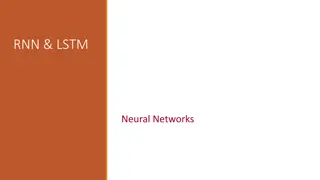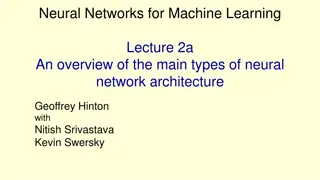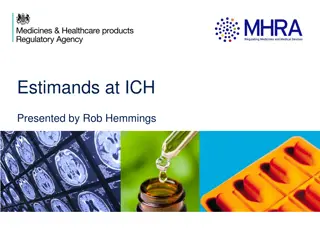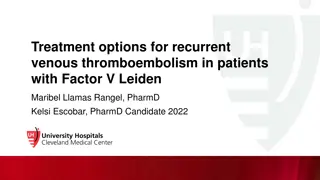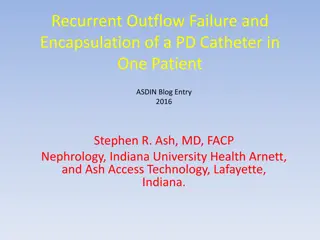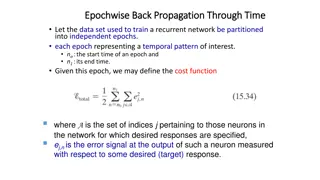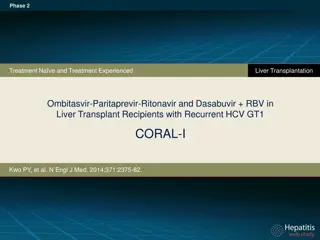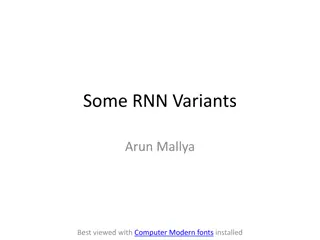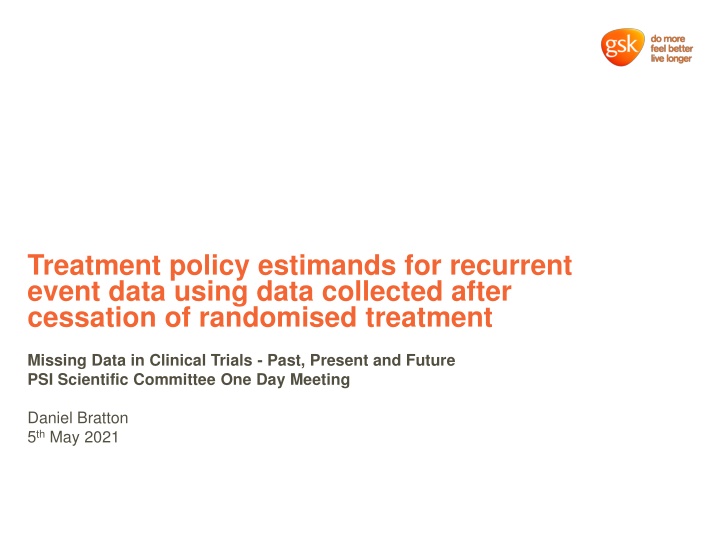
Treatment Policy Estimands for Recurrent Event Data
Treatment policy estimands for recurrent event data in clinical trials, focusing on missing data and imputation after treatment cessation. Learn about off-treatment data collection, analysis approaches, and patient trajectories.
Download Presentation

Please find below an Image/Link to download the presentation.
The content on the website is provided AS IS for your information and personal use only. It may not be sold, licensed, or shared on other websites without obtaining consent from the author. If you encounter any issues during the download, it is possible that the publisher has removed the file from their server.
You are allowed to download the files provided on this website for personal or commercial use, subject to the condition that they are used lawfully. All files are the property of their respective owners.
The content on the website is provided AS IS for your information and personal use only. It may not be sold, licensed, or shared on other websites without obtaining consent from the author.
E N D
Presentation Transcript
Treatment policy estimands for recurrent event data using data collected after cessation of randomised treatment Missing Data in Clinical Trials - Past, Present and Future PSI Scientific Committee One Day Meeting Daniel Bratton 5thMay 2021
Acknowledgements James Roger Oliver Keene Bhabita Mayer Juan Abellan Pharmaceutical Statistics 2018; 18(1): 85-95 2
Outline On- & Off-treatment data Imputation of missing recurrent event data after study-withdrawal Assumptions around off-treatment and post-study-withdrawal periods SAS macros Example: METREO trial, mepolizumab for chronic obstructive pulmonary disease (COPD) (NCT02105961) 3
Off-treatment data A treatment policy estimand is often interested in the efficacy of treatment regardless of treatment discontinuation In the past, many RCTs only collected on-treatment data, i.e. data collected up to the point of treatment discontinuation Analyses restricted to imputing missing data under assumptions drawn from these data only However, RCTs now commonly attempt to collect off-treatment data, i.e. after treatment discontinuation, but study-withdrawal still occurs Reduces the amount of missing data in the study vs collecting on-treatment data only Provides the opportunity to impute post-study-withdrawal data based on the observed off-treatment data Thus allows potentially more plausible assumptions to be made for the missing post- study-withdrawal data which is also likely to be considered off-treatment 4
Common analysis approaches Commonly used analysis methods may treat the observed data as coming from a single period, e.g. Under missing at random (MAR) assumption, mean event rate after withdrawal is then a weighted mean of event rate during on- and off-treatment periods Alternatively, in the usual Jump to Reference (J2R) approach all post- withdrawal data is imputed based on the observed placebo data Such analyses do not distinguish between data collected on- and off- treatment which are likely to have differing underlying event rates Unobserved outcomes may more closely mirror those observed during the off-treatment period Therefore wish to assume that event rate after study withdrawal is the same as that during the off-treatment period (off-treatment imputation) 6
Imputation of missing recurrent event data Period 1 Observed On-treatment Period 2 Observed Off-treatment Period 3 Unobserved (Off-treatment) Suppose a patient has y1 exacerbations during Period 1 and then discontinues study treatment but remains in follow-up During Period 2 the patient has y2 exacerbations and then prematurely withdraws from the study Alternatively a patient may withdraw from treatment and study simultaneously (y2 = 0) Want to estimate y3, the number of unobserved exacerbations in Period 3 conditioned on y1 and y2 7
Assumed event rate for Missing period X= event it = event rate in period i for treatment t (0=Placebo, 1=Active) Discontinue study treatment Withdraw from study Week 0 Week 52 ? X X X On-treatment (i=1) Off-treatment (i=2) Missing (i=3) True Rate 1t 2t 3t MAR (on+off) J2R (on+off) Off- treatment On- treatment? *t *t *t *0 1t 2t 2t 1t 2t 11 8
Off-treatment imputation missing data assumptions Post-study withdrawal On-treatment Off-treatment True Rate 1t 2t 3t Off-treatment imputation 1t 2t 2t Post-study-withdrawal can be assumed to have same event rate as the observed off- treatment period in the same arm: 3t = 2t Could lead to issues if there is little observed off-treatment data on a particular arm At least 50% of the post-treatment-discontinuation period needs to be observed to avoid large reduction in precision of estimated effect (Roger et al 2018) Alternatively, can assume patients have the same event rate post-treatment- discontinuation regardless of treatment assignment: 3t = 2* Could be realistic if for example the treatment has a rapid washout period May help to avoid imputation issues caused by a lack of off-treatment data relative to missing data on a particular arm 9
Multiple imputation methods Set up dataset to provide appropriate assumption around the unobserved period (see later slide) Two approaches to imputation model (Roger et al 2018): 1) Negative multinomial regression number of missing events conditional on number of observed events is also negative multinomial (Keene et al 2014) 2) Negative binomial mixed model with subject-specific random effect Apply usual MI methods: Take multiple random samples from relevant imputation model for missing period Compute total number of events for each subject (y1 + y2 + y3) Analyse each imputed dataset using same model as primary analysis Repeat multiple times (e.g. 5000 imputations) Combine estimates using Rubin s rules 10
SAS macros SAS macros for multiple imputation of recurrent event data written by James Roger are available from DIA Missing Data page*: NegBinMI: can perform multiple imputation in situations the observed and unobserved data are each assumed to come from a single period (Keene et al 2014). Uses negative multinomial approach NM_Reg: generalisation of NegBinMI to any number of periods (i.e. on-, off- and post- study-withdrawal) NM_Rand: Also performs multiple imputation for any number of periods, using joint modelling approach but tends to be slower than NM_Reg Allow different references for the unobserved periods, for example in NM_Reg/Rand: Off-treatment data within the same arm All off-treatment data (e.g. all patients assumed to have similar outcomes once withdrawing from treatment) Off-treatment reference in active arm only, no distinction between on-/off-treatment period in placebo arm * https://www.lshtm.ac.uk/research/centres-projects-groups/missing-data#dia-missing-data 11
SAS Macros Data Set-up 1) Separate off-treatment periods by treatment group P = Placebo, A = Active, D = Duration (months), Y = number of events Imputed outcomes (e.g.) Analysis dataset Raw dataset Pt. Trt. * Period D Y MI Trt.- Period Imp. Pt. MI Trt.- Period Y* 1 P-On 6 3 P-On 1 1 P-On 3 Imp. Pt. Trt. D Y 1 P-Off 3 2 P-Off 1 1 P-Off 2 1 1 P 12 7 1 P-Miss 3 P-Off 1 1 P-Off 2 ? 1 2 A 12 1 2 A-On 10 0 A-On 1 2 A-On 0 2 A-Off 1 1 A-Off 1 2 A-Off 1 2 A-Miss 1 A-Off 1 2 A-Off 0 ? 12
SAS Macros Data Set-up 2) Combining off-treatment periods by treatment group P = Placebo, A = Active, D = Duration (months), Y = number of events Imputed outcomes (e.g.) Analysis dataset Raw dataset Pt. Trt. * Period D Y MI Trt.- Period Imp. Pt. MI Trt.- Period Y* 1 P-On 6 3 P-On 1 1 P-On 3 Imp. Pt. Trt. D Y 1 P-Off 3 2 Off 1 1 Off 2 1 1 P 12 6 1 P-Miss 3 Off 1 1 Off 1 ? 1 2 A 12 2 2 A-On 10 0 A-On 1 2 A-On 0 2 A-Off 1 1 Off 1 2 Off 1 2 A-Miss 1 Off 1 2 Off 1 ? 13
SAS Macros Data Set-up 3) Off-treatment imputation for active arm only; placebo on/off-treatment effect assumed equal P = Placebo, A = Active, D = Duration (months), Y = number of events Imputed outcomes (e.g.) Analysis dataset Raw dataset Pt. Trt. * Period D Y MI Trt.- Period Imp. Pt. MI Trt.- Period Y* 1 P-On 6 3 P 1 1 P 3 Imp. Pt. Trt. D Y 1 P-Off 3 2 P 1 1 P 2 1 1 P 12 6 1 P-Miss 3 P 1 1 P 1 ? 1 2 A 12 2 2 A-On 10 0 A-On 1 2 A-On 0 2 A-Off 1 1 A-Off 1 2 A-Off 1 2 A-Miss 1 A-Off 1 2 A-Off 1 ? 14
Example - METREO study design COPD patients at high risk of exacerbations despite SoC background therapy 52 week treatment period; patients dosed every 4 weeks Double blind treatment Placebo SC (N=226) Total N=674 Mepolizumab 100mg SC (N=223) Mepolizumab 300mg SC (N=225) Subjects discontinuing randomised treatment encouraged to remain in follow-up off- treatment Primary endpoint: rate of moderate/severe exacerbations during 52-week treatment period 15
Extent of off-treatment & missing data Mepolizumab 100mg SC (N=223) Mepolizumab 300mg SC (N=225) Number of patient-years Placebo (N=226) On-treatment 195.4 (86%) 205.9 (92%) 203.0 (90%) Off-treatment 13.2 (6%) 10.0 (4%) 10.8 (5%) Missing 18.1 (8%) 7.3 (3%) 12.0 (5%) Percentages based on total time on-treatment, off-treatment and missing. Total time missing for a subject withdrawing from study = 1 number of years on-treatment and off-treatment 16
METREO: Results of Post Hoc Imputation Analyses Rate Ratios vs Placebo Estimate (95% CI) Estimate (95% CI) Estimate (95% CI) Estimate (95% CI) Estimate (95% CI) Estimate (95% CI) Mepolizumab 100mg SC Mepolizumab 100mg SC Mepolizumab 100mg SC Missing at Random 0.80 (0.65, 0.98) Jump to Reference 0.81 (0.65, 0.99) Off-treatment Imputation 0.81 (0.66, 1.00) Mepolizumab 300mg SC Mepolizumab 300mg SC Mepolizumab 300mg SC Missing at Random 0.86 (0.70, 1.05) Jump to Reference 0.87 (0.70, 1.07) Off-treatment Imputation 0.90 (0.73, 1.11) 0.4 0.6 0.8 1 1.2 1.4 1.6 1.8 2 Rate Ratio (Mepo / Placebo) 17
Results of Post Hoc Imputation Analyses Exacerbation rates (Observed Margins estimates) Mepolizumab 100mg SC (N=223) Mepolizumab 300mg SC (N=225) Placebo (N=226) Analysis MAR 1.49 1.19 1.27 J2R 1.48 1.20 1.29 Off-treatment 1.43 1.16 1.29 18
Conclusions Often wish to estimate effect of treatment regardless of the event of treatment discontinuation (treatment policy estimand) Many confirmatory studies now continue to collect data after a patient has discontinued study treatment Provides opportunity to use the observed off-treatment data to impute data post study-withdrawal which is also likely to be off-treatment, provided sufficient off- treatment data collected For recurrent event data this can be achieved using negative multinomial modelling, or mixed modelling approach with subject-specific random effect Flexible SAS macros available for implementing both methods of analysis Can handle any number of assumed post-randomisation periods Allows missing data assumptions to vary, e.g. specific to arm or patient Require no more than ~50% of the off-treatment period to be unobserved for effective imputation 19
References Akacha M, Ogundimu EO. Sensitivity analyses for partially observed recurrent event data. Pharmaceutical Statistics 2016; 15:4-14. Carpenter JR, Roger JH, Kenward MG. Analysis of longitudinal trials with protocol deviation: a framework for relevant, accessible assumptions, and inference via multiple Imputation. Journal of Biopharmaceutical Statistics 2013; 23:1352-1371. Keene ON, Jones MRK, Lane PW, Anderson J. Analysis of exacerbation rates in asthma and chronic obstructive pulmonary disease: example from the TRISTAN study. Pharmaceutical Statistics 2007; 6:89-97. Keene ON, Roger JH, Hartley BF, Kenward MG. Missing data sensitivity analysis for recurrent event data using controlled imputation. Pharmaceutical Statistics 2014; 13:258- 264. Pavord DM, Chanez P, Criner GJ et al. Mepolizumab for Eosinophilic Chronic Obstructive Pulmonary Disease. New England Journal of Medicine 2017; DOI: 10.1056/NEJMoa1708208 Roger JH, Bratton DJ, Mayer B et al. Treatment policy estimands for recurrent event data using data collected after cessation of randomised treatment. Pharmaceutical Statistics 2018; 18(1):85-95 20




